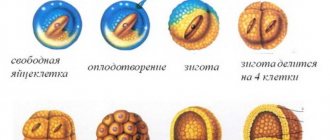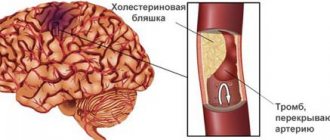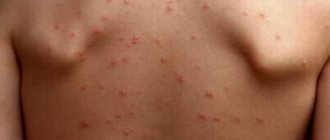December 07, 2020
Chickenpox is an infectious disease caused by the Varicella-Zoster virus (the third group of the herpes family). This disease is treated in children by a pediatrician, in adults by a therapist; the infection is characterized by a profuse itchy rash on the skin and surface of the mucous membranes.
Chickenpox is an infectious disease caused by the Varicella-Zoster virus (the third group of the herpes family). This disease is treated in children by a pediatrician, in adults by a general practitioner; the infection is characterized by a profuse itchy rash on the skin and surface of the mucous membranes. The incubation period for chickenpox can range from 10 days to 3 weeks. Chickenpox is highly contagious and the virus is transmitted through direct contact with a carrier.
Children often get sick in entire groups (groups in kindergarten or classes at school). When the virus first enters the human body, it provokes chickenpox, most often this occurs at the age of 3-6 years. Having chickenpox forms a stable immune response of the body to repeated infection; after 6 years of age, 70% of children already have stable immunity to this disease.
Once infected, the virus remains latent in nerve cells and can regenerate, causing a secondary infection called herpes zoster, also called “shingles.” It usually occurs in adults aged >50 years or in frail and immunocompromised individuals. Accompanied by a painful rash that can lead to permanent nerve damage.
The causative agent of chickenpox
The main causative agent of chickenpox is the varicella zoster virus, which belongs to the general family of herpes viruses type 3.
Infection with the pathology occurs through the air through close interaction with a sick person.
The pathogen itself is very weak in the external environment, and if it does not penetrate the body, it dies instantly after 10 minutes.
If the virus infects the mucous membranes, the infection develops quickly. The pathogen spreads throughout the bloodstream, causing the appearance of characteristic clinical symptoms.
Epidemiology
The causative virus (varicella zoster) belongs to the herpetic family and, in addition to chickenpox, can lead to the appearance of shingles. But chickenpox, of course, is the most common manifestation of this infection.
Most often, this disease is observed in children approximately 6 years old (associated with visiting organized children's groups). Infants under 6 months have maternal antibodies, so they are immune to the disease.
Before the age of 10, about 80% of the child population suffers from chickenpox. Almost 88% experience a moderate form of the disease, and 4.5% do not even have a fever.
More than 7% of children suffer from a severe form of the disease.
Chickenpox symptoms
It is quite difficult to detect viral pathology at the initial stage. Because it has similarities with ARVI and influenza. Subsequently, after infection, characteristic signs of chickenpox appear, which help differentiate the disease from other conditions. Therefore, any doctor, taking into account the overall clinical picture, can accurately make a diagnosis.
As a rule, the main symptoms of chickenpox in adults and children are:
- Intoxication syndrome - this includes headache, high temperature, body aches, enlarged lymph nodes, chills, sore throat and sore throat.
- Weakness and malaise.
- Poor appetite.
- Skin rashes. Red sores (vesicles) appear all over the body and are filled with serous contents.
- Severe itching.
The very first sign of chickenpox is considered to be an increase in temperature, which occurs 1-2 days before the dermatological rash. It is accompanied by other striking signs of intoxication, usually lasting about 5 days. Chickenpox without fever and catarrhal symptoms is quite rare.
The rash affects all parts of the body, including mucous surfaces and hair. First, spots appear, then medium-sized bubbles with a clear liquid form in their place. After some time, the formations on the skin become cloudy and dry out, becoming covered with a thin crust.
The complete disappearance of papules occurs 2-3 weeks after the onset of the pathological process. The most important thing is to not scratch the skin. Otherwise, infection may occur.
CHICKENPOX IN CHILDREN: SYMPTOMS, COURSE, TREATMENT
Home — Social networks — CHICKENPOX IN CHILDREN: SYMPTOMS, COURSE, TREATMENT
CHICKENPOX IS A DISEASE THAT IS NOT LOSSING ITS POPULARITY. WHOLE KINDERGARTENS AND FAMILIES HAVE IT: CHILDREN, ADULTS, FUTURE MOMS. BUT DESPITE THE FELLOWSHIP, THE SYMPTOMS AND TREATMENT OF CHICKENPOX IN CHILDREN AND ADULTS CONTINUE TO CAUSE MANY QUESTIONS. TODAY OUR EXPERTS WILL ANSWER THE MOST COMMON OF THEM.
WHAT IS CHICKENPOX
Varicella zoster virus is a type of herpes. More precisely: the herpetic virus varicella zoster (Varicella zoster), the 3rd type of herpes viral infection. The signature sign of chickenpox is a blistering rash that often covers the entire body (although there are also cases of localized rashes). In the past, each such pimple was supposed to be smeared with brilliant green, so in our country chickenpox is firmly associated with children with green spots. Dr. Komarovsky even has a joke about this: “A spotted green rash is a characteristic symptom of chickenpox.” When the blisters burst, they cause itching, which can lead to scratching and secondary infection of the wounds. The “favorite” season of the disease is considered to be autumn-winter, and epidemic outbreaks are recorded once every 5 years.
Chickenpox predominantly affects children aged 1 to 10-12 years, and the majority of cases are among children 3-4 years old.
HOW INFECTION WITH CHICKENPOX OCCURS
Susceptibility to the chickenpox virus is very high because it is very volatile - it covers distances of up to 20 m, from floor to floor, through ventilation. Chickenpox is transmitted through the mucous membranes of the eyes and upper respiratory tract. But the virus has several ways of entering someone else’s body from a patient. The virus literally travels with the wind: through airborne droplets - when talking, coughing, crying loudly, or screaming. It spreads through contact and household contact - infection with saliva or fluid from a pimple. Transmitted by direct touch. A pregnant woman with chickenpox can infect her child, since the virus passes transplacentally, that is, through the placental barrier from mother to fetus.
To become infected with chickenpox, it is enough to communicate with someone who has chickenpox or someone who has shingles (herpes zoster), and chickenpox infection will occur even with fleeting contact with him. The period of contagiousness of chickenpox in patients begins at the end of the incubation period (48 hours before the appearance of the rash) and continues until the 5th day from the moment the last pimple appears. Moreover, the incubation period of chickenpox in children and adults is not typical at all and does not manifest itself in any way for 1-3 weeks (at least 7 days), so it is impossible to say exactly when those same 48 hours before the appearance of acne will occur.
INCUBATION PERIOD OF CHICKENPOX
The incubation period, that is, the time from the moment of introduction to the first signs of chickenpox, is 11-23 days. During this period, the pathogen penetrates through the mucous membrane of the upper respiratory tract, then multiplies and accumulates in the epithelial cells of these mucous membranes.
After the maximum accumulation of the chickenpox pathogen, it spreads through the lymphatic and blood vessels.
In some patients (there are very few of them), the end of the incubation period is marked by scarlet-like rashes. This may be the first sign of chickenpox in children and adults. This condition lasts literally one day, several hours, then the rash disappears, the temperature rises to 37-38⁰C.
WHEN DOES THE RASCH APPEAR DURING CHICKENPOX?
After the incubation period, the period of rash begins. These are the most obvious and first signs of chickenpox in children and adults. The period of rash lasts for 3-5 days, while the lymph nodes enlarge, the temperature rises to 37-39°C, persisting throughout the entire period of the rash. Also, each new outbreak of rashes is usually accompanied by a rise in temperature.
WHAT DOES THE RASHE (ACNE) LOOK LIKE WITH CHICKENPOX
A rash with chickenpox appears on the 1st day of the onset of intoxication, with breakouts (the appearance of new pimples) within 5 days - some pimples are already going away, while others are just appearing. Therefore, it seems that the patient has pimples of different types: blisters, spots, and crusts at the same time.
The rash does not have a favorite localization; rashes can even be on the scalp, on the mucous membrane of the mouth, genital organs in girls and women, conjunctiva/cornea, and larynx. All these pimples mature and heal within 5 days, and the rash is accompanied by itching of varying intensity. Against itching, various doctors recommend using antihistamines, wet wraps or even baths. During the first day, the red spot turns into a blister and after a couple of days the rash looks on the surface of the body like “dew drops” with transparent contents, which becomes cloudy after 1-2 days, and after another 1-2 days the blister dries out and turns into a crust that falls off after 1-3 weeks.
WHY ARE PIMLES LUBRICATED WITH ZELENKA
As Dr. Komarovsky wittily noted, speaking about chickenpox: “Painting a child with brilliant green is a personal matter for his parents, determined by their love of painting and has nothing to do with treatment.” In fact, brilliant green does not treat chickenpox rash, but is a medical marker with which the appearance of new pimples on the patient’s body is noted. As soon as new objects for staining with brilliant green stop appearing on the skin of a child with chickenpox, and old pimples have crusted over, that’s it, the child is no longer contagious. Nowadays, pimples are smeared with brilliant green only by those who firmly believe that it is one of the mandatory means of treating chickenpox. But this is a misconception. You can't cure pimples, you can only wait until they go away on their own. To avoid secondary infection of the skin, it is necessary to prevent scratching in the area of acne. To do this, you need to purchase other drugs from pharmacies that are specially created to eliminate symptoms of such diseases. They relieve itching, dry, have a cooling effect and, by the way, are also not completely colorless.
WHEN DOES A PATIENT WITH CHICKENPOX STOP BEING INFECTIOUS?
A patient with chickenpox ceases to be contagious as soon as the appearance of new pimples has stopped, and crusts have already formed on all existing ones. The recovery period lasts for 3 weeks from the end of the rash and is characterized not only by the falling off of the crusts, but also by the formation of lifelong immunity. After the crusts fall off, dark spots remain, which disappear within a few weeks. There are no scars left unless there is a secondary infection.
CHICKENPOX IN INFANTS
Breastfed newborns up to 6 months usually do not get sick due to antibodies received from the mother, but only if the mother herself has previously had chickenpox or has been vaccinated. If the mother has not passed on these antibodies to the baby (not having them herself), then the baby may get chickenpox. Please note that we are talking specifically about breastfed babies. Formula-fed babies do not have such antibody protection.
In a sick infant, the disease is severe. Against the background of high temperature, intracranial pressure may increase, which will be indicated by visible pulsation of the fontanel and convulsions. The rashes in such babies are profuse and the maturation of the rash proceeds more slowly, becoming protracted - up to 9 days, instead of 5. Bacterial complications often occur.
For this reason, all newborns whose mothers have not had chickenpox or were infected a few days before birth, as well as all premature babies under 1 kg, regardless of the mother’s infectious history, must be administered a special immunoglobulin. This is not a vaccination against chickenpox, but temporary protection against it until the child is strong enough to cope with this virus on his own, unless, of course, the mother chooses vaccination over the disease.
It is worth noting that children who are not in a group, children under 3 years of age, as a rule, very rarely have the opportunity to become infected with chickenpox. Adults also rarely get this disease.
IS IT DIFFICULT TO IDENTIFY CHICKENPOX?
In typical cases (and this is the majority of cases of chickenpox), the diagnosis of the disease is established on the basis of characteristic clinical data of the disease. The clinical picture of chickenpox is so typical that there is simply no need for additional diagnostics.
However, in some cases, when the disease does not proceed in a completely typical manner, it may be necessary to carry out a differential diagnosis of chickenpox with other viral infectious diseases, mainly those that are accompanied by similar symptoms. We are talking, first of all, about influenza, parainfluenza, measles; in some cases, differential diagnosis with rubella may be required. For this, a blood test is done.
IS IT POSSIBLE TO CONFUSE CHICKEN POX AND RUBELLA?
The doctor, of course, will not confuse these diseases. For doubting patients, you need to keep in mind their obvious differences. With chickenpox, a polymorphic rash is most often observed, that is, spots, crusts, and blisters are simultaneously present on the skin. With rubella, only a pinkish rash can be observed. With chickenpox, the temperature can rise to 40°C; with rubella, it occasionally reaches 39°C. The rubella virus is dangerous for the fetus; the chickenpox virus does not pose such an acute danger to pregnant women. Chickenpox can be complicated by inflammatory phenomena on the skin, but this does not happen with rubella. Chickenpox rarely goes away with catarrhal symptoms; with rubella, redness of the pharynx and catarrh of the upper respiratory tract almost always occur.
HOW TO TREAT CHICKENPOX IN CHILDREN?
If a child of the first year gets sick with chickenpox, treatment is carried out only under the supervision of a doctor with possible hospitalization
, because the course of infectious processes in young children is prone to generalization, frequent and severe complications and high mortality!
In children aged 2 to 10-12 years after diagnosis (with primary chickenpox), specific treatment for uncomplicated chickenpox is not carried out (and patients are not painted with brilliant green). All manipulations with a patient with chickenpox are associated with the relief of symptoms, namely: reducing the temperature with antipyretics (except aspirin) and relieving skin itching, if any. If the child does not look lethargic, if his temperature is not too high, then you should not convince him that he is very sick and needs bed rest. Children under 10-12 years of age suffer from chickenpox quite easily. And the only thing that usually torments them is the itching of the chickenpox rash. This problem is solved by using antihistamines.
To prevent the child from scratching the skin in areas of chickenpox rash, parents will have to monitor him and distract him. It is also necessary to monitor the child’s nails, and very young children can wear special mittens - “scratchies”. There is also a “grandmother’s” way to help a child with severe itching, even if antihistamines do not help - this is a feather. In the past, children were relieved of itching with a goose feather - with its help, mothers “scratched” especially disturbing places on the skin, without creating scratches.
A month after recovery from chickenpox, the doctor examines the patient, with an appointment for an immunological examination and specialist examination. Preventive vaccinations cannot be given within 1 month.
IS QUARANTINE FOR CHICKENPOX REQUIRED?
In the not-too-distant past, quarantine due to chickenpox was as commonplace as wearing war paint with brilliant green on children affected by this virus. But now, when there is a mass incidence of chickenpox, kindergartens and schools are usually not closed for quarantine. Groups and classes in which children with chickenpox have been identified continue to function, but they may be subject to temporary (up to three weeks) bans on outings, on contacts with children from other groups (classes), as well as on the admission of new children to them .
Drug treatment of chickenpox
Local therapy plays a special role in the treatment of rashes. It helps improve the healing of skin surfaces, preventing the appearance of scars, cicatrices and secondary infection of pimples.
It is advisable to treat skin lesions with any antiseptic agents. These are brilliant green, Tsindol, Baneotsin, Fukortsin. This group of drugs eliminates re-infection of elements, promotes their rapid drying and epithelization.
The most modern medicine is Calamine. It is applied topically and has a complex antiallergic and antiseptic effect.
Also prescribed for the treatment of the infectious process:
- Antipyretic drugs. Reduces temperature and improves well-being.
- Antiviral agents. They are used to destroy the main infectious agent.
- Antihistamines. Suppresses severe itching and prevents other signs of allergies. Used for oral and external use.
- Painkillers. Fight headaches and throat discomfort. Used in tablet form.
When localizing papular elements in the oral cavity, it is recommended to use:
- Boric acid 1% as an antiseptic.
- Kamistad, Kalgel and other painkillers.
- Sea buckthorn oil or Solcoseryl to reduce irritation and accelerate epithelization.
Clinical manifestations
The severity of symptoms can vary greatly between children. General manifestations will be as follows:
- increased body temperature;
- rash of roseolous-papular nature (pink spots in the center of which a vesicle appears);
- manifestations of intoxication (poor appetite, weakness and lethargy, headache);
- symptoms from other organs (not skin).
The first signs of chickenpox in children appear acutely. Often body temperature rises to high values (39˚C). Skin rashes appear either simultaneously with hyperthermia or several hours later.
The first elements of the rash are located on the border of the scalp of the forehead, as well as on the torso, arms and legs. With massive rashes, the palms and plantar surfaces of the feet may be affected. At first there is no bubble in the papules, it appears after a few hours, the diameter is from 2 to 5 mm.
The course is characterized by an undulating course: every 2–4 days, rashes are added en masse, which is also accompanied by an increase in body temperature. After 2-3 days, the vesicle opens, crusts form, which fall off without leaving scars.
This is how a typical version of chickenpox occurs in most children.
Possible complications
- Aesthetic skin problems. After pockmarks, there may be blisters on the skin, small potholes, like after acne, etc., which cannot always be eliminated later.
- Pneumonia. Most often this happens to children whose immunity is significantly weakened.
- Brain damage (so-called “chickenpox encephalitis”). A rare but possible phenomenon associated with chickenpox, in which certain areas of the brain are temporarily “attacked.” Which, accordingly, causes disorder of behavior and facial expressions, tremors and loss of coordination. However, with proper therapy it can be successfully treated.
- Reye's syndrome (“acute hepatic encephalopathy”). This is a very rare, but at the same time very serious disease, which, according to some medical studies, occurs due to the use of drugs based on acetylsalicylic acid (for example, aspirin) in the treatment of chickenpox.
It should be remembered that most complications with chickenpox (as with other viral infections) occur due to dehydration. Give your child plenty of water and the risk of any complications will be significantly reduced.
Prevention
A person who has chickenpox develops acquired immunity, which remains normal for life.
Vaccination can be used for prevention in children who have not been ill. The Oka virus strain has been well studied and widely used. But among clinicians the attitude towards mass vaccination is ambiguous, which is primarily caused by the cost of the project.
Preventive measures also include quarantine. Chickenpox has a long incubation period of 21 days, so quarantine for contact children is introduced for 3 weeks.
Recently, cases of recurrent chickenpox have begun to occur. They are called breakthrough chickenpox. Most often, such cases are associated with disturbances in the child’s immune system.
As can be seen from the above, chickenpox is not just a rash and fever in childhood. This is a disease that requires a qualified approach to treatment and observation.
For more information about the symptoms of chickenpox and its treatment, watch the video:
This article has been verified by a current qualified physician, Victoria Druzhikina, and can be considered a reliable source of information for site users.
The drug Cycloferon
The most studied and well-proven immunostimulant in clinical practice is the original domestic drug cycloferon. Its active ingredient - methylglucamine acridone acetate - stimulates the production of interferons alpha, beta and gamma - protective molecules that are secreted by the body's cells in response to the invasion of viruses. Cycloferon changes the vital processes of the cell in such a way that it becomes immune to the virus and does not participate in its reproduction, and also activates immune cells - lymphocytes and macrophages.
How does cycloferon work?
In the treatment of herpetic rashes, including chickenpox, a form of methylglucamine acridone acetate for external use is used - cycloferon liniment. It penetrates the skin, stimulating the production of interferons in it. In addition, cycloferon liniment contains an antiseptic that prevents the occurrence of secondary purulent bacterial infection. Thanks to this, the disease progresses much easier.
Cycloferon liniment is produced in consumer-friendly, economical packaging (5 ml tubes) and is compatible with all other medications, that is, it can be used as part of complex therapy.
THE DECISION ON THE USE OF CYCLOFERON LINIMMENT is made by the attending DOCTOR.
Zaplutanov V. A., LLC NTFF "POLYSAN"
The danger of chickenpox
Chickenpox is highly contagious - the virus is easily transmitted through tiny droplets of saliva and mucus when coughing, sneezing and talking. Many viral particles are also contained in the liquid from the opening vesicles, so you can become infected by touch. Due to such high contagiousness, chickenpox usually affects many children in children's institutions at once, becoming a frequent reason for quarantine. For the same reason, most people “manage” to get sick from it even in preschool age. If the first contact with the virus occurred in adulthood, the disease is often more severe - with high fever, general weakness and more rash.
Atypical course
The insidiousness of the disease is that visible rashes on the skin are accompanied by similar, but invisible rashes on all the membranes of the internal organs. Visually you can see a rash on the mucous membranes of the mouth and throat.
Like any viral infection, chickenpox leads to a decrease in the content of lymphocytes in the blood. This means that the antimicrobial link of immunity sags and the body is exposed to bacterial attacks and complications. Purulent inflammation of the skin, conjunctivitis, stomatitis, pneumonia, etc. appear.
Encephalitis
The chickenpox virus itself carries the risk of neurological complications.
Chickenpox encephalitis (inflammation of the brain) is the most common neurological complication.
Its manifestations most often occur on days 5–8 of illness, although cases of encephalitis developing before the appearance of the rash have been described. This complication definitely requires qualified help.
Manifests itself as a disorder of consciousness. Seizures occur in 15–20% of patients.
Symptoms:
- unsteadiness of gait;
- imbalance;
- shaking (tremor) of the head;
- chanted speech;
- paralysis of the head muscles.
The earlier this complication develops, the more severe the course should be feared. In most children, chickenpox encephalitis is benign, but in severe forms of the disease there is a risk of neuron death, which can lead to dangerous consequences.
Doctor's advice
If the baby did not have chickenpox, but did not become infected from contact with a sick child, this may indicate that he suffered the disease asymptomatically. An accurate answer to the question can only be obtained by donating blood for antibodies to the varicella zoster virus - IgG and IgM to Varicella-Zoster. The presence of antibodies will indicate a fresh or previously suffered process. Absence will show that the child has not yet had chickenpox.
Victoria Druzhikina Neurologist, Therapist
Serositis
Rashes on the membranes of internal organs (serous membranes) rarely manifest themselves clinically. But cases have been described in which complications such as pericarditis and pleurisy occurred. It is necessary to treat only under medical supervision.
Treatment
Protecting a child from infection is very problematic: a significant percentage are asymptomatic cases of chickenpox, in which the sick child does not have clinical manifestations of infection and continues to attend the children's group. Naturally, other children become infected if they do not have immunity.
Regarding treatment, it should begin with a visit to the doctor. Based on the earliest signs of chickenpox, a pediatrician will be able to predict its course and indicate what medications are needed in each specific case.
Lubricating rashes with a solution of brilliant green has two goals: preventing the addition of a bacterial infection and the ability to assess the progression of the disease.
Drug treatment is based on antiviral drugs and prevention of bacterial infection.
Following the recommendations of a qualified specialist will minimize the risk of complications. If they develop, take treatment measures as quickly as possible.










